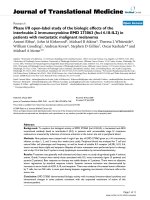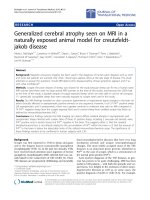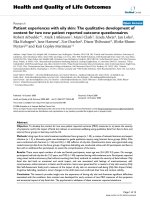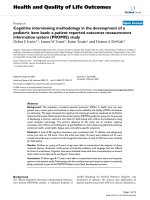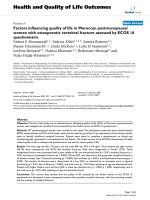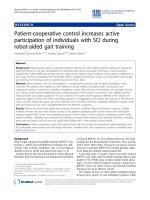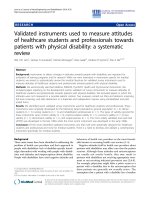báo cáo hóa học:" Factors associated with "Ikigai" among members of a public temporary employment agency for seniors (Silver Human Resources Centre) in Japan; gender differences" ppt
Bạn đang xem bản rút gọn của tài liệu. Xem và tải ngay bản đầy đủ của tài liệu tại đây (256.09 KB, 6 trang )
BioMed Central
Page 1 of 6
(page number not for citation purposes)
Health and Quality of Life Outcomes
Open Access
Research
Factors associated with "Ikigai" among members of a public
temporary employment agency for seniors (Silver Human
Resources Centre) in Japan; gender differences
Kokoro Shirai*
1
, Hiroyasu Iso
1
, Hideki Fukuda
2
, Yasuhiro Toyoda
1
,
Toshio Takatorige
1
and Kozo Tatara
3
Address:
1
Graduate School of Social and Environmental Medicine, Osaka University, Japan,
2
Graduate School of Biomedical Science, Nagasaki
University, Japan and
3
Department of Life and Welfare, University of the Air, Japan
Email: Kokoro Shirai* - ; Hiroyasu Iso - ;
Hideki Fukuda - ; Yasuhiro Toyoda - ;
Toshio Takatorige - ; Kozo Tatara -
* Corresponding author
Abstract
Background: "Ikigai" is culturally defined in the society of Japan as a comprehensive concept
describing subjective well-being. It is considered to be related to life-satisfaction, self-esteem,
morale, happiness as well as evaluation towards meaning of one's life. Although previous studies
examined factors associated with Ikigai with smaller samples, consistent results have not been
obtained, especially from the viewpoint of gender differences. Identification of gender-specific
factors related with Ikigai among the elderly, may be of value to enhance subjective well-being.
Methods: Self-administered questionnaires were distributed among 4,737 randomly selected
members of the Silver Human Resources Centre (SHRC), a public temporary employment agency
for seniors, in Osaka, Japan. This represents about 10% of all registered members (n = 41,593) in
the 38 SHRC centres in Osaka. A total of 4,376 subjects (male: 2,913; female: 1,463) provided a
satisfactory response to the questionnaire (response rate: 92%). The status whether they have
"Ikigai" or not was evaluated by self-anchoring scale ranging from 0 to 5 (0 = lowest rate and 5 =
highest rate of having "Ikigai"). Also, self-rated life-change score through work (-3 to 3) was
evaluated by three items, i.e.) changes in (1) the number of friends through work, (2) social
interests and (3) the quantity of conversation with others (1 = increase, 0 = no change, and -1 =
decrease).
Results: The factors associated with "Ikigai" for total subjects were the number of rooms in one's
residence, annual income, healthy life style score (Breslow), the number of working days through
SHRC, satisfaction with one's life history and life-change sore through work. The multivariable odds
ratio (95%CI) of having "Ikigai" was 1.9 (1.1–3.3) for persons with no change in life thorough work
compared with subjects with a score of Ϲ-1. Moreover, the multivariable odds ratios were 3.5
(1.9–6.6) for a life-change score = 1, 3.1 (1.7–5.7) for a score = 2 and 7.8 (4.0–15.2) for a score =
3 compared with persons with a score of Ϲ-1.
For male subjects, other factors associated with having "Ikigai" were the number of rooms in their
residence, annual income, the number of working days through SHRC, subjective assessment of
Published: 27 February 2006
Health and Quality of Life Outcomes2006, 4:12 doi:10.1186/1477-7525-4-12
Received: 02 December 2005
Accepted: 27 February 2006
This article is available from: />© 2006Shirai et al; licensee BioMed Central Ltd.
This is an Open Access article distributed under the terms of the Creative Commons Attribution License ( />),
which permits unrestricted use, distribution, and reproduction in any medium, provided the original work is properly cited.
Health and Quality of Life Outcomes 2006, 4:12 />Page 2 of 6
(page number not for citation purposes)
health condition, and degree of satisfaction with their life history. For female, the corresponding
factors were the presence of a spouse and degree of satisfaction with their life history.
Conclusion: Scores for life-changes through work were associated with a higher prevalence of
having "Ikigai" for both male and female. For male, "Ikigai" tended to be associated with physical
condition and socioeconomic factors such as the size of their residence or annual income, while
for female, family relations such as having spouse and psychological factors such as satisfaction with
one's life history were significant factors. In spite of the design limitations of this study, it is possible
to conclude that the recognition of life change through obtaining work may enhance "Ikigai" among
people who wish to engage in productive activities in their later stages of life for both male and
female. SHRC has a potential to provide resources for fulfilling one's "Ikigai" through supporting
working opportunities to realize life changes for both elder male and female.
Background
Japan has experienced one of the largest increase in the
proportion of persons aged 65 years and over in the
world. The proportion of the elderly is 19.5% in 2005,
and is expected to reach 25.2% in 2015 [1]. Health pro-
motion and support for quality of life for the elderly is
therefore an important task in such a society. In this con-
nection, the idea that psychosocial conditions are related
to the enhancement of health and reducing the risk of
mortality in later stage of life is attracting growing atten-
tion. Most commonly, subjective well-being [2-5], social
relations [6-10], participating productive activities and
meaningful engagement towards one's life [11-14] have
been studied as psychosocial factors associated with
health and mortality of older populations.
These studies showed that lower levels of a subjective
well-being and lack of a sense that life is worth living were
associated with an increased risk of mortality. A subjective
well-being and a feeling that life is worth living may rep-
resent prognostic factors for longevity and healthy aging
in the later stages of life. A subjective well-being is often
assessed with measures such as self-esteem, life satisfac-
tion, self-concept, morale, depression, SF-36, QOL index,
happiness and loneliness [15]. These measures represent
evaluations of different aspects of well-being; for example,
happiness and loneliness tend to constitute dimensions
of emotional aspects, whereas the other assesses cognitive
evaluation towards one's life [16].
However, "Ikigai" is understood as a comprehensive con-
cept related to emotions, i.e) happiness and life-satisfac-
tion, as well as to the cognitive evaluation of the meaning
of one's life, self-esteem and self-efficacy.
In the present study, we focused on the concept of "Iki-
gai", which is culturally defined as a subjective evaluation
of well-being among Japanese, and examined factors asso-
ciated with "Ikigai", which is with an awareness of impor-
tance to use the term originated in the basis of cultural
background and social norms [17]. Lyons (1998) refers to
"Ikigai" as "What makes one feel good about oneself as a
valued member of society who is in control of one's life",
and Mathews (1996) stated that "Ikigai" is "What makes
life worth living" [18]. More recently, some researchers
have used the exact term "Ikigai" to report on its relation-
ship with objective and subjective evaluation of health
conditions [19-23]. It has also been reported that "Ikigai"
varies among generations, and is modified by social activ-
ities and social networks [24-26].
The concept of "Ikigai" can be an important supportive
element for health among the elderly [19-22], not only for
those who are frail, but also for those who wish to main-
tain or promote their health and life. Traditional hypoth-
eses of social gerontology, such as engagement theory and
continuous theory supported the relationship with oppor-
tunities to engage in productive activity and subjective
well-being in terms of concept of successful aging [3].
Therefore, we realize the importance of "Ikigai" among
the elderly who are relatively fit and willing to participate
in social activities, but are still struggling to find ways to
enhance their quality of life.
We chose the subjects as elderly persons who were willing
to engage in productive activities as members of the Silver
Human Resources Centre (SHRC), which is one of the
social resources for providing temporary work for the eld-
erly. We hypothesized that to obtain work through SHRC
may change their life and enhance "Ikigai" among the eld-
erly. We therefore tried to explore the factors associated
with "Ikigai" among those who are engaging in productive
activities after their retirement age.
Also, previous studies indicated that gender differences in
the evaluation of subjective well-being [26-28]. For exam-
ple, male tended to report themselves as independent,
achievement-oriented, financially-oriented, and more
competitive than female [27,28], while female were more
likely to describe themselves as sociable, moral, depend-
ent and less assertive [28,29]. Furthermore, it was
reported that female tended to have the greater access to
Health and Quality of Life Outcomes 2006, 4:12 />Page 3 of 6
(page number not for citation purposes)
sources of subjective well-being and to engage more in
processes to protect the self than did male [30]. Those
studies indicated that male and female show different
presentation of their evaluation toward subjective well-
being. Therefore, we specifically examined gender differ-
ences in factors associated with "Ikigai".
Methods
Study population
The survey was conducted among 4,737 randomly
selected members of the Silver Human Resources Center
(SHRC) in Osaka, Japan. There were a total of 41,593
members registered at the 38 SHRC centers in Osaka,
from each of which about 10% of the registered members
were randomly selected. A self-administered question-
naire was distributed after a full explanation of the pur-
pose of the project had been given, and informed consent
had been obtained from a total of 4,376 subjects (male,
2,913; female, 1,463) for a response rate of 92%. Relevant
details about the subjects are shown in Table1 (see addi-
tional file 1).
The SHRC is a vocational introductory and placement
agency for persons aged 60 years old and over in Japan
since 1975. SHRC, supported in part by local and national
governments, provides working opportunities for older
individuals in order to support their fulfilment of life
through engaging in productive activities. This institution
provides job opportunities as paid work. However, the
primary purpose of the institution is to enhance "Ikigai"
though providing job opportunities as social activity not
merely as economical activities.
Measurement of psychosocial conditions
The concept of "Ikigai" was defined as "sense of life worth
living" and the status whether they recognize themselves
to have "Ikigai" or not was evaluated by self-anchoring
scale [31] with a range from 0 to 5 (0 = lowest rate of hav-
ing "Ikigai": meaning having no "Ikigai", and 5 = highest
rate of having "Ikigai"). Usually, psychosocial factors are
evaluated by means of scales consisting of multiple items
to assess multidimensional aspects of certain feelings,
conditions, cognitions or emotions. In our study, how-
ever, we assessed "Ikigai" by evaluating to what extent
people themselves recognize that they have "Ikigai" or
not. In addition, we employed a self-rated score for evalu-
ating an awareness of changes in life in terms of relations
with others through work (life-change score through
work: -3 to 3) consisting of three items: (1) change in the
number of friends as a result of working opportunity pro-
vided by SHRC; (2) change in social interests through
working opportunity provided by SHRC and (3) change
in the quantity of conversation with others through work-
ing opportunity provided by SHRC (increase = 1, no
change = 0, decrease = -1).
Based on the result of the Cronbach α coefficient (α =
0.776), it was considered the validity of this score was
acceptable. Other psychological conditions were investi-
gated through the following questions: (1) Are you satis-
fied with what you have done trough your past life?
("Satisfaction with my life history"; yes = 1, no = 0); (2)
Do you want to work in the community to use what you
have learned and experienced to make a contribution to
society? ("Wish to contribute to society"; yes = 1, no = 0);
(3) Do you want to have time for yourself to relax in the
later stages of your life? ("Wish to have time for myself";
yes = 1, no = 0)
Related variables and statistical analysis
We used demographic, economic and health-related
measures as covariates for the multivariable modelling
process. For evaluation of health-related conditions, sub-
jective assessment of health condition was scored from
very bad (1) to very good (5). To dichotomize subjective
assessment of health condition, "very good", "good" and
"average" were categorized as good health. A healthy life-
style was evaluated by using Breslow's 7 items (0–7). The
number of days of hospitalization and of seeking medical
consultation during the preceding year was self-reported.
Due to the small number of subjects hospitalized (6.3%
of the total), the hospitalization record was dichotomized
into two categories (none = 0, more than 1 day = 1).
To assess financial circumstances, the number of rooms in
the respondent's residence was used to evaluate housing
property (1–2, 3, 4, 5, м6), and annual income including
pension benefits was assessed in terms of Japanese yen
(<1, 1–1.9, 2–3.9, 4–5.9, м6 million per year). In addi-
tion, satisfaction with one's living standard was evaluated
in terms of the following categories: very satisfied, satis-
fied and not satisfied. The number of days (0–250) work-
ing trough SHRC during the preceding year was self-
reported. The primary purpose of seeking work at SHRC
was assessed as financial benefits (31.5%), health mainte-
nance (39.5%), communicating with friends and business
establishments (18.8%), learning new skills and knowl-
edge (3.0%), contributing to society (5.9%) and other
(1.3%). Because there were few responses for some of
these categories, financial benefits, health maintenance
and communicating with friends were considered to be
the main purposes of seeking work and the rest were cate-
gorized as "other". Gender differences for the distribution
and mean values of these factors were examined by means
of Kruskal-Wallis and ANOVA test respectively.
For total, male and female subjects, linear regression anal-
ysis for "Ikigai" score (0 to 5) and multivariable-adjusted
logistic regression analysis for having "Ikigai" ("Ikigai"
score > 0) were used to determine factors associated with
having "Ikigai". The presence of interaction with gender
Health and Quality of Life Outcomes 2006, 4:12 />Page 4 of 6
(page number not for citation purposes)
was tested by using cross-products in terms of gender and
related factors. All analyses were conducted using SPSS
©
ver.11.05J for Windows (SPSS Inc., Chicago, IL, USA). All
P values for statistical tests were two-tailed and P < 0.05
was regarded as statistically significant.
Results
Table 1 (see additional file 1) shows the characteristics of
SHRC members enrolled in this study. Over 85.8% of the
subjects were 60–74 years old. A higher proportion of
female (26.9%) than male (3.8%) were living alone,
while 34.7% of female and 60.1% of male were living
with their spouse. As for financial status, 62.8% of male
reported 2–3.9 million yen as annual income, whereas
43.7% of female reported less than 1 million yen as their
annual income. However, differences in satisfaction with
living standards between male and female were not signif-
icant, with 63.5% of male and 59.9% of female reporting
to be satisfied. In terms of health, those who were hospi-
talized more than 1 day during the preceding year
accounted for 7.1% of male and 4.8% of female, while the
mean number of days for seeking medical consultation
was 21 days for either gender. Male produced a higher
healthy lifestyle score (mean value = 3.6) than female
(mean value = 3.5). The mean number of days of work
provided by SHRC was higher for male (mean value =
99.9 days) than for female (mean value = 86.6 days). The
proportion of a score of 3 for changes in life style as a
result of work (all 3 categories increased positively) was
31.3% for male and 33.4% for female.
Table 2 (see additional file 2) shows factors associated
with "Ikigai" score (0–5) as determined by linear regres-
sion analysis. Factors associated with "Ikigai" were age,
sex, having a spouse, the number of rooms, annual
income, healthy lifestyle, the number of working days
through SHRC, purpose of work, satisfaction with one's
life history, a wish to have time for oneself and self-rated
life-changes score through work (adjusted R
2
= 0.20; p <
0.001). Among male, the significant factors were the
number of rooms in one's residence, annual income,
healthy lifestyle, purpose of work (for financial benefit),
purpose of work (for financial maintenance), satisfaction
with one's life history, wish to contribute to society, wish
to have time for oneself and score for life-changes through
work. For female the factors associated with "Ikigai" were
age, number of rooms in one's residence, healthy lifestyle,
satisfaction with one's life history and score for life-
changes through work. Subjective assessment of health
condition was not associated with "Ikigai" for either sex.
Factors related to having "Ikigai" (no = 0; yes м1) were
examined further by means of logistic regression analysis
(Table 3 [see additional file 3]). Overall, persons with a
higher score for life-change through work showed a
higher odds ratio for having "Ikigai" (Figure 1). In com-
parisons with persons with a score of Ϲ-1, the multivaria-
ble odds ratio (95%CI) for having "Ikigai" was 1.9 (1.1–
3.3) for a score of 0, 3.5 (1.90–6.6) for a score of 1, 3.1
(1.70–5.7) for a score of 2, and 7.8 (4.02–15.2) for a score
of 3. Satisfaction with one's life history and wish to have
time for oneself were also related to having "Ikigai". Other
associated factors were a better subjective assessment of
health, a higher healthy lifestyle score, a larger number of
rooms in one's residence, a higher annual income and a
greater number of working days through SHRC.
For male, the factors associated with having "Ikigai" were
a larger number of rooms, a higher annual income, a
greater number of working days through SHRC, better
subjective health condition a higher healthy lifestyle
score, satisfaction with one's life history and a higher self-
rated life-change score. For female, the corresponding fac-
tors were the presence of a spouse, satisfaction with one's
life history and a higher self-rated life-change score. There
was a significant gender difference in the association
between annual income and "Ikigai" (P for interaction
<0.05).
Discussion
The score for life-changes through work was associated
with a higher prevalence of having "Ikigai" for both male
and female. Furthermore, our study suggested there were
several gender differences for factors associated with "Iki-
gai". For male, physical condition and socioeconomic fac-
tors such as annual income, the number of rooms in one's
residence and work for financial benefit were closely asso-
ciated with "Ikigai", while for female family relations such
as having a spouse and psychological factors were associ-
ated factors.
Multivariable odds ratios of having "Ikigai" according to life-change scores through workFigure 1
Multivariable odds ratios of having "Ikigai" according
to life-change scores through work. **P for trend <
0.001
҇
**
**
**
**
Health and Quality of Life Outcomes 2006, 4:12 />Page 5 of 6
(page number not for citation purposes)
A meta-analysis by Pinquart and Sorensen (2000) [30]
reported supportive results of our study. It mentioned that
social and environmental situations were more strongly
related to life satisfaction and happiness among male,
while social integration was more strongly related among
female. Piquart & Sorensen (2001) [15] also reported that
income was associated with happiness for male but not
for female. Furthermore, our results are consistent with
those for community residents aged 60 and over as
reported by Fujimoto et al. (2004) [26]. They also sug-
gested that male showed a closer relationship with physi-
cal condition, having an occupation and playing a role in
society, while female showed a closer connection between
"Ikigai" and family and psychological factors, such as less
depressive symptoms (GDS) and more life satisfaction
(LSI-K). Moreover, although the gender differences
observed in our study reached statistical significance only
for annual income, we examined them after controlling
potential confounding factors, while previous studies
examined gender differences only descriptively and did
not examined interactions.
Male but not female showed a significant association
between working days and "Ikigai". Furthermore, both
male and female showed significant relations of life
change score, as well as satisfaction on one's life history
with "Ikigai". This suggests that not only obtaining work,
but also being a member of SHRC may increase opportu-
nities to meet people, to have conversations with others
and to contact with social events, leading to obtain "Iki-
gai". In this study, it was not possible to explore structural
pass to understand how they recognize "Ikigai". However,
it may be possible to imply that SHRC provides a positive
influence towards the elderly who wish to engage in work
in their late stage of life. In other word, SHRC will be con-
sidered as one of the rewardable social resources in the
aged society. Furthermore, since male and female showed
different factors associated with "Ikigai", SHRC should
provide the elderly a variety of types and periods of work,
such as paid work, non-paid work as well as volunteer
work according to their wish.
Conclusion
Since this study was designed as a cross-sectional study, it
was not possible to determine the causal effect of working
opportunities obtained through SHRC on having "Ikigai".
Furthermore, this study did not have a control group of
not having work opportunities at all in the same genera-
tion. However, within the members of people who have
chance to engage in productive activities, we found a sig-
nificant dose-response relationship between the number
of working days through SHRC and "Ikigai" among both
male and overall subjects. Moreover, both male and
female reported having more "Ikigai" when they became
aware of positive changes in their life in terms of relations
with others through participating in productive activities,
such as having more frequent conversation with people,
gaining greater interest in life, and getting more friends
through work opportunities. Therefore, in spite of the lim-
itations of the study design, it can be concluded that rec-
ognition of life change through obtaining work may
enhance "Ikigai" among people who wish to engage in
productive activities in the later stages of life. A longitudi-
nal study or a clinical trial will be necessary to confirm this
finding. Our findings also suggest that both male and
female can increase their "Ikigai" through different path-
ways which warrant further research. SHRC has demon-
strated its potential to provide resources for enhancing
"Ikigai" through providing work opportunities for both
elderly male and female.
Authors' contributions
Kokoro Shirai participated in the study concept and
design, acquisition of data, analysis and interpretation of
data, and drafting of the manuscript. Hiroyasu Iso partic-
ipated in analysis and interpretation of data, and the help
for drafting of the manuscript, and provided statistical
expertise. Hideki Fukuda participated in the study concept
and design, acquisition of data, analysis of data and inter-
pretation of data, and the help for drafting of the manu-
script. Yasuhiro Toyoda helped for critical revision of the
manuscript. Toshio Takatorige participated in the study
concept and design, acquisition of data and the help for
critical revision of the manuscript. Kozo Tatara partici-
pated in the study concept and design, acquisition of data,
interpretation of data, and the help for critical revision of
the manuscript and supervised the conduct of the study.
Additional material
Additional File 1
Table 1: Characteristics of the members of Silver Human Resource Center
(SHRC) in Japan
Click here for file
[ />7525-4-12-S1.pdf]
Additional File 2
Table 2: Factors associated with "Ikigai" score
Click here for file
[ />7525-4-12-S2.pdf]
Additional File 3
Table 3: Odds ratio (95% CI) of having "Ikigai" by gender
Click here for file
[ />7525-4-12-S3.pdf]
Publish with Bio Med Central and every
scientist can read your work free of charge
"BioMed Central will be the most significant development for
disseminating the results of biomedical research in our lifetime."
Sir Paul Nurse, Cancer Research UK
Your research papers will be:
available free of charge to the entire biomedical community
peer reviewed and published immediately upon acceptance
cited in PubMed and archived on PubMed Central
yours — you keep the copyright
Submit your manuscript here:
/>BioMedcentral
Health and Quality of Life Outcomes 2006, 4:12 />Page 6 of 6
(page number not for citation purposes)
Acknowledgements
The authors wish to express their sincere appreciation to the Society for
Silver Human Resources Center (SHRC) in Osaka, Japan, which cooperated
with this survey conducted at all centers of the SHRC in Osaka. This study
was supported in part by Grants-in-Aid for Scientific Research from the
Japan Society for the Promotion of Science (JSPS) and by a JSPS Research
Fellowship for Young Scientist.(No.17-9216).
References
1. Ministry of labor and welfare: Annual reports on Health and Welfare:
Social Security and National life. Tokyo 2005.
2. House JS, Landis KR, Umberson D: Social relationships and
health. Science 1998, 241:540-545.
3. Rowe JR, Kahn RL: Successful Aging New York: Pantheon books; 1998.
4. Maier H, Smith J: Psychological predictors of mortality in old
age. J Gerontol B Psychol Sci Soc Sci 1999, 54:44-54.
5. Koivumaa-Honkanen H, Honkanen R, Viinamaki H, Heikkila K, Kaprio
J, Koskenvuo M: Self-reported life satisfaction and 20 year
mortality in healthy Finnish adults. Am J Epidemiol 2000,
152:983-991.
6. Berkman LF, Syme SL: Social networks, host resistance, and
mortality: A nine-year follow-up study of Alameda County
residents. Am J Epidemiol 1979, 109:186-204.
7. Murata C, Takaaki K, Hori Y, Miyao D, Tamakoshi K, Yatsuya H,
Sakakibara H, Toyoshima H: Effects of social relations on mor-
tality among the elderly in a Japanese rural area: An 88-
month follow-up study. J Epidemiol 2005, 15:78-84.
8. Bowling A: Social support and social network: Their relation-
ship to the successful and unsuccessful survival of elderly
people in the community. An analysis of concepts and a
review of the evidence. Fam Prac 1991, 8:68-83.
9. Sugisawa H, Liang J, Liu X: Social networks, social support and
mortality among older people in Japan. J Gerontol B Psychol Sci
Soc Sci 1994, 49:S3-13.
10. Lund R, Modvig J, Due P, Holstein BE: Stability and change in
structural social relations as predictor of mortality among
elderly women and men. Eur J epidemiol 2000, 16:1087-1097.
11. Glass TA, de Leon CM, Marottoli RA, Berkman LF: Population
based study of social and productive activities as predictors
of survival among elderly Americans. BMJ 1999, 319:478-483.
12. Ceria CD, Masaki KH, Rodriguez BL, Chen R, Yano K, Curb JD: The
relationship of psychosocial factors to total mortality among
older Japanese-American men: The Honolulu heart pro-
gram. J Am Geriatr Soc 2001, 49:725-731.
13. Welin L, Tibblin G, Svardsudd K, Tibblin B, Ander-Peciva S, Larsson
B, Wilhelmsen L: Prospective study of social influences on mor-
tality. The study of men born in 1913 and 1923. Lancet 1985,
1:915-918.
14. Okamoto K, Tanaka Y: Subjective usefullness and 6-year mor-
tality risks among elderly persons in Japan. J Gerontol B Psychol
Sci Soc Sci 2004, 59:246-249.
15. Pinquart M, Sorensen S: Gender difference in self-concept and
psychological well-being in old age: A Meta-Analysis. J Geron-
tol B Psychol Sci Soc Sci 2001, 56:195-213.
16. McNeil JK, Stones MJ, Kozma A: Subjective well-being in later
life: Issues concerning measurement and prediction. Soc Indic
Resear 1986, 18:35-70.
17. Oishi S, Diener E: Goals, culture, and subjective well-being.
Pers Soc Psychol Bulletin 2001, 27:1674-1682.
18. Mathews G: What makes life worth living? How Japanese and Americans
make sense of their worlds Berkeley: University of California Press;
1996.
19. Nakanishi Y, Tatara K: Relationship between social relations
and mortality of older Japanese people living alone. J Clin
Geropsychol 2000, 6:213-222.
20. Kaplan GA, Salonen JT, Cohen RD, Brand RJ, Syme SL, Puska P: social
connections and mortality from all causes and from cardio-
vascular disease: Productive evidence from eastern Finland.
Ameri J Epidemiol 1988, 128:370-380.
21. Nakanishi N, Tatara K, Takatorige T, Murakami S, Sinsho F: Effects
of preventive health services on survival of the elderly living
in a community in Osaka, Japan. J Epidemiol Community Health
1997, 51:199-204.
22. Nakanishi N, Fukuda H, Tatara K: Change in Psychosocial condi-
tions and eventual mortality in commuity-residing elderly
people. J Epidemiol 2003, 13:72-79.
23. Nakamura Y, Kaneko I, Kawamura Y, Sakano T, Naito K, Maeda K,
Kurobe M, Hirata S, Yazaki T, Goto Y, Hashimoto S: Related fac-
tors with subjective health condition in community-residing
elderly people. Nippon Kosyu Eisei Zasshi 2002, 49:409-416.
24. Hasegawa A, Hujiwara Y, Hoshi T, Shinkai S: Regional differences
in ikigai (reason (s) for living) in elderly people -Relationship
between ikigai and family structure, physiological situation
and functional capacity Nihon Rounen-igaku Zasshi 2003,
40:390-396.
25. So J, Imu H, An S, Okada S, Shirasawa M: Factors associated with
Ikigai among Big-city dwelling older population who are liv-
ing at home. J Healt Welf Stat 2004, 51:1-6.
26. Fujimoto K, Okada T, Izumi T, et al.: Factors defining Ikigai of
older adults who are living at home. J Healt Welf Stat 2004,
51:24-32.
27. Angeleitner A: Health, sociometric status and self perception
in the elderly: An Application of the interpersonal checklist.
Int J Aging Hum Dev 1978, 8:293-299.
28. Mutran E, Reitzes D, Bratton D, Fernandez M: Self-esteem and
subjective responses to work among mature workers: Simi-
larities and differences by gender. J Gerontol B Psychol Sci Soc Sci
1987, 52:S89-S96.
29. Siegler I, George LK, Okun M: Cross-sequential analysis of adult
personality. Dev Psychol 1979, 15:350-351.
30. Pinquart M, Sorensen S: Influence of socioeconomic status,
social network, and competence on psychological well-being
in the elderly. Psychol Aging 2000, 15:187-224.
31. Kondo T: Efficiency of self-anchoring scale to measure the
feeling that life is worth living in the aged. Nihon Rounen-igaku
Zasshi 2003, 14:339-344.
